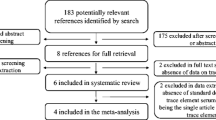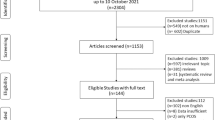Abstract
To investigate the serum concentrations of 11 heavy metals and trace elements in patients with polycystic ovary syndrome (PCOS). A total of 369 women (including 96 patients with PCOS) were studied. No differences with statistical significance in the median barium, cadmium, lead, arsenic, chromium, gallium, strontium, and vanadium concentrations were observed between the patients with PCOS and the control group. Serum nickel (Ni) (P = 0.000) and copper (Cu) (P = 0.000) levels were significantly higher, but zinc (Zn) levels (P = 0.009) were significantly lower in patients with PCOS compared with the control group. The results of the association between metal levels and hormone levels indicated that Ni, Cu, and Zn may play a role in the pathogenesis of PCOS related with reproductive hormone levels. The findings in the present study should be investigated with further trials in order to obtain new insights into PCOS.
Similar content being viewed by others

References
Skrgatic L, Baldani DP, Cerne J, Ferk P, Gersak K (2012) CAG repeat polymorphism in androgen receptor gene is not directly associated with polycystic ovary syndrome but influences serum testosterone levels. J Steroid Biochem Mol Biol 128(3):107–112
Coskun A, Arikan T, Kilinc M, Arikan DC, Ekerbiçer HÇ (2013) Plasma selenium levels in Turkish women with polycystic ovary syndrome. Eur J Obstet Gynecol Reprod Biol 168(2):183–186
Lin M-W, Tsai S-J, Chou P-Y, Huang M-F, Sun HS, Wu M-H (2012) Vitamin D receptor 1a promotor −1521 G/C and −1012 A/G polymorphisms in polycystic ovary syndrome. Taiwan J Obstet Gynecol 51(4):565–571
Matalliotakis I, Kourtis A, Koukoura O, Panidis D (2006) Polycystic ovary syndrome: etiology and pathogenesis. Arch Gynecol Obstet 274(4):187–197
Wood JR, Nelson VL, Ho C, Jansen E, Wang CY, Urbanek M, McAllister JM, Mosselman S, Strauss JF (2003) The molecular phenotype of polycystic ovary syndrome (PCOS) theca cells and new candidate PCOS genes defined by microarray analysis. J Biol Chem 278(29):26380–26390
Liu X, Hu Q, Fang Z, Zhang X, Zhang B (2009) Magnetic chitosan nanocomposites: a useful recyclable tool for heavy metal ion removal. Langmuir 25(1):3–8
Kurdoglu Z, Kurdoglu M, Demir H, Sahin H (2012) Serum trace elements and heavy metals in polycystic ovary syndrome. Hum Exp Toxicol 31(5):452–456
Pollack AZ, Schisterman EF, Goldman LR, Mumford SL, Albert PS, Jones RL, Wactawski-Wende J (2011) Cadmium, lead, and mercury in relation to reproductive hormones and anovulation in premenopausal women. Environ Health Perspect 119(8):1156
Jackson L, Howards P, Wactawski-Wende J, Schisterman E (2011) The association between cadmium, lead and mercury blood levels and reproductive hormones among healthy, premenopausal women. Hum Reprod 26(10):2887–2895
Krieg EF Jr (2007) The relationships between blood lead levels and serum follicle stimulating hormone and luteinizing hormone in the third National Health and Nutrition Examination Survey. Environ Res 104(3):374–382
Gallagher CM, Moonga BS, Kovach JS (2010) Cadmium, follicle-stimulating hormone, and effects on bone in women age 42–60 years, NHANES III. Environ Res 110(1):105–111
Chakraborty P, Ghosh S, Goswami S, Kabir SN, Chakravarty B, Jana K (2013) Altered trace mineral milieu might play an aetiological role in the pathogenesis of polycystic ovary syndrome. Biol Trace Elem Res 152(1):9–15
Zhang X, Fu L, Zhang Q, Yan L, Ma Y, Tu B, Liu N, Qiao J (2011) Association of TRB3 Q84R polymorphism with polycystic ovary syndrome in Chinese women. Reprod Biol Endocrinol 9:46
Zhao S, Qiao J, Li M, Zhang X, Yu J, Li R (2007) Discovery of distinct protein profiles for polycystic ovary syndrome with and without insulin resistance by surface-enhanced laser adsorption/ionization time of flight mass spectrometry. Fertil Steril 88(1):145–151
Xing X-y, Yang W-y, Yang Z-j (2003) The diagnostic significance of homeostasis model assessment of insulin resistance in metabolic syndrome among subjects with different glucose tolerance. Chinese J Diabetes 12(3):182–186
Goullé J-P, Mahieu L, Castermant J, Neveu N, Bonneau L, Lainé G, Bouige D, Lacroix C (2005) Metal and metalloid multi-elementary ICP-MS validation in whole blood, plasma, urine and hair: reference values. Forensic Sci Int 153(1):39–44
Salnikow K, Zhitkovich A (2007) Genetic and epigenetic mechanisms in metal carcinogenesis and cocarcinogenesis: nickel, arsenic, and chromium. Chem Res Toxicol 21(1):28–44
Haber L, Erdreicht L, Diamond G, Maier A, Ratney R, Zhao Q, Dourson M (2000) Hazard identification and dose response of inhaled nickel-soluble salts. Regul Toxicol Pharmacol 31(2):210–230
Flores CR, Puga MP, Wrobel K, Garay Sevilla ME, Wrobel K (2011) Trace elements status in diabetes mellitus type 2: possible role of the interaction between molybdenum and copper in the progress of typical complications. Diabetes Res Clin Pract 91(3):333–341
Wu HD, Chou SY, Chen DR, Kuo HW (2006) Differentiation of serum levels of trace elements in normal and malignant breast patients. Biol Trace Elem Res 113(1):9–18
Ceylan OM, Demirdöğen BC, Mumcuoğlu T, Aykut O (2013) Evaluation of essential and toxic trace elements in pseudoexfoliation syndrome and pseudoexfoliation glaucoma. Biol Trace Elem Res 153(1–3):28–34
Linder MC (2012) The relationship of copper to DNA damage and damage prevention in humans. Mutat Res Fundam Mol Mech Mutagen 733(1):83–91
Tapiero H, Tew KD (2003) Trace elements in human physiology and pathology: zinc and metallothioneins. Biomed Pharmacother 57(9):399–411
Chimienti F, Aouffen M, Favier A, Seve M (2003) Zinc homeostasis-regulating proteins: new drug targets for triggering cell fate. Curr Drug Targets 4(4):323–338
Blostein-Fujii A, DiSilvestro RA, Frid D, Katz C, Malarkey W (1997) Short-term zinc supplementation in women with non-insulin-dependent diabetes mellitus: effects on plasma 5′-nucleotidase activities, insulin-like growth factor I concentrations, and lipoprotein oxidation rates in vitro. Am J Clin Nutr 66(3):639–642
Guler I, Himmetoglu O, Turp A, Erdem A, Erdem M, Onan MA, Taskiran C, Taslipinar MY, Guner H (2014) Zinc and homocysteine levels in polycystic ovarian syndrome patients with insulin resistance. Biol Trace Elem Res 158(3):297–304
Nestler JE (1997) The role of hyperinsulinemia in the pathogenesis of the polycystic ovary syndrome and its clinical implications. In: Seminars in reproductive endocrinology. GEORG THIEME VERLAG, p 111–122
Baillargeon J-P, Iuorno MJ, Nestler JE (2003) Insulin sensitizers for polycystic ovary syndrome. Clin Obstet Gynecol 46(2):325–340
De Leo V, la Marca A, Petraglia F (2003) Insulin-lowering agents in the management of polycystic ovary syndrome. Endocr Rev 24(5):633–667
Poretsky L, Cataldo NA, Rosenwaks Z, Giudice LC (1999) The insulin-related ovarian regulatory system in health and disease. Endocr Rev 20(4):535–582
Puder JJ, Müller B, Keller U (2005) Letter re: The biological variation of testosterone and sex hormone-binding globulin (SHBG) in polycystic ovarian syndrome: implications for SHBG as a surrogate marker of insulin resistance. J Clin Endocrinol Metab 90(7):4419–4420
González F, Rote NS, Minium J, Kirwan JP (2006) Reactive oxygen species-induced oxidative stress in the development of insulin resistance and hyperandrogenism in polycystic ovary syndrome. J Clin Endocrinol Metab 91(1):336–340
Sabuncu T, Vural H, Harma M, Harma M (2001) Oxidative stress in polycystic ovary syndrome and its contribution to the risk of cardiovascular disease☆. Clin Biochem 34(5):407–413
Fenkci V, Fenkci S, Yilmazer M, Serteser M (2003) Decreased total antioxidant status and increased oxidative stress in women with polycystic ovary syndrome may contribute to the risk of cardiovascular disease. Fertil Steril 80(1):123–127
Speisky H, Gómez M, Burgos-Bravo F, López-Alarcón C, Jullian C, Olea-Azar C, Aliaga ME (2009) Generation of superoxide radicals by copper–glutathione complexes: redox-consequences associated with their interaction with reduced glutathione. Bioorg Med Chem 17(5):1803–1810
Uchida Y, Ohba K-i, Yoshioka T, Irie K, Muraki T, Maru Y (2004) Cellular carbonyl stress enhances the expression of plasminogen activator inhibitor-1 in rat white adipocytes via reactive oxygen species-dependent pathway. J Biol Chem 279(6):4075–4083
Taylor CG (2005) Zinc, the pancreas, and diabetes: insights from rodent studies and future directions. BioMetals 18(4):305–312
Song Y, Wang J, Li X-k, Cai L (2005) Zinc and the diabetic heart. BioMetals 18(4):325–332
Acknowledgments
This work was supported in part by the Medical Science and Technology Innovation Project of Nanjing Military region (10MA065) and the project of the Xiamen Science and Technology Program (2013Z20134027). We thank Professor John Hodgkiss for his assistance with English.
Conflict of interest
The authors declare that there are no conflicts of interest.
Author information
Authors and Affiliations
Corresponding authors
Additional information
Guanchao Zheng and Lijun Wang are co-first authors.
Rights and permissions
About this article
Cite this article
Zheng, G., Wang, L., Guo, Z. et al. Association of Serum Heavy Metals and Trace Element Concentrations with Reproductive Hormone Levels and Polycystic Ovary Syndrome in a Chinese Population. Biol Trace Elem Res 167, 1–10 (2015). https://doi.org/10.1007/s12011-015-0294-7
Received:
Accepted:
Published:
Issue Date:
DOI: https://doi.org/10.1007/s12011-015-0294-7



